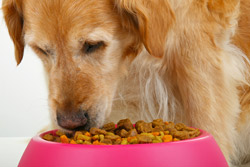
Lately we have been seeing more and more commercials on television and in print about lifestyle nutrition, including an emphasis on different diets for different ages of pets. It is relatively easy to determine when a dog or cat becomes an adult versus a kitten or puppy, but the shift from adult to senior is less clear, particularly when it comes to dogs.
The reason for this is that smaller breeds of dogs tend to age at a slower rate than large and giant breeds. However, the changes that signal the onset of aging generally begin to occur at around 6-8 years of age in dogs and around 9 years of age in cats. Most veterinarians agree that dogs are considered to be senior or geriatric at 7 years of age, while cats that are more than 10 are considered elderly. And, in the past few decades, we have seen a rise in the average age of dogs and cats, with more and more pets that are over the age of 10.
Often an early sign of aging in our pets is a change in the coat or hair, such as grey hair in the coat, particularly around the chin or face, a change in the texture of the hair, or thinning of the haircoat. Skin becomes less elastic and more fragile, and may become either drier or greasier, depending on the pet. It is common for the pet’s claws to become drier and more brittle with age, and nails may break off more easily or become thicker and somewhat misshapen. You may need to trim your pet’s nails more often because of these changes, and your pet may need more frequent bathing.
Changes in your pet’s digestive system may lead to decreased ability to digest nutrients from their food, leading to problems such as weight loss or loss of muscle mass. Some pets become obese in old age, while others become thin and bony. In both of these cases, diet changes are necessary.
Older animals are more at risk for developing diseases such as thyroid disorders, liver problems, kidney problems, high blood pressure, heart disease, dental disease, muscle and/or joint problems such as arthritis, etc. Many of our pets hide the signs of sore or aching joints from us, and the only subtle sign of problems may be decreased activity as shown by a reluctance to play, climb stairs or jump up onto furniture.
Since many of these age-related problems can be difficult to spot by the average owner until they are advanced, senior pets should visit the veterinarian more often. Annual checkups are considered to be the normal for adult cats and dogs, but once a pet becomes senior, twice a year checkups are advisable so that your veterinarian can look for subtle signs of problems before they become serious.
Since dogs and cats age at a much faster rate than humans, visiting the veterinarian every six months would be the equivalent of visiting your doctor for a complete physical examination every 3 or 4 years! A geriatric examination for your pet will always include a complete physical examination and will also include periodic evaluations of blood, urine and fecal samples as well as other tests depending on the individual patient.
Over the past several decades, research into optimal nutrition in both humans and animals has resulted in the formulation of nutritional recommendations that provide the right blend of fats, proteins, carbohydrates, minerals and vitamins to slow the signs of aging and help deal with problems that accompany aging. Seniors need a different diet than adult cats and dogs. On your next visit to the veterinarian with your older pet, you should talk about these recent advances in clinical nutrition, so that you can make an informed decision about what is best for your furry friends and how you can help prolong their lives.
